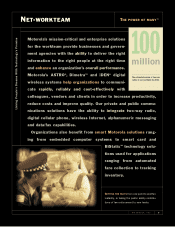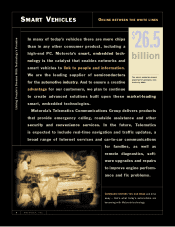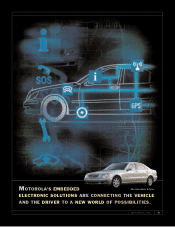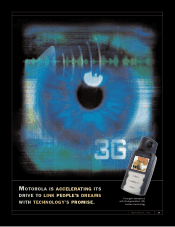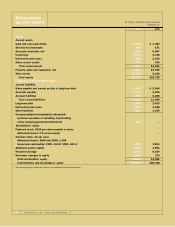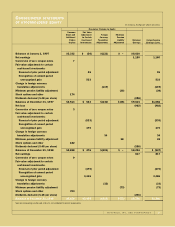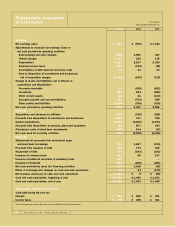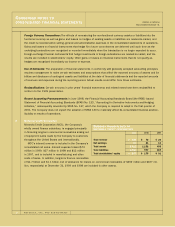Motorola 1999 Annual Report Download - page 18
Download and view the complete annual report
Please find page 18 of the 1999 Motorola annual report below. You can navigate through the pages in the report by either clicking on the pages listed below, or by using the keyword search tool below to find specific information within the annual report.
17 MOTOROLA, INC.
chip markets. After a difficult 1998, the Semiconductor Products Sector completed its
restructuring, achieved nearly a $1 billion reduction in its breakeven point, and returned to
profitability. Our Integrated Electronic Systems Sector, which repositioned itself around
embedded systems, recorded improved results. The sector sold its non-semiconductor com-
ponents group and now focuses on systems solutions in the automotive, communications
and computer markets. The Telematics Communications Group had significantly higher sales.
TOTAL SOLUTIONS THROUGH ALLIANCES A second objective to create value is to provide total
solutions for our customers by forming alliances. Many of these key alliances are enabling
Motorola to bring the Internet new life by bringing it to wireless, as discussed on pages 3-4.
The Wireless Application Protocol (WAP) standardizes the way a wireless telephone accesses
and displays Internet content. Motorola led the development of the WAP Forum, which is now
backed by more than 175 of the world’s leading telecommunications and software companies.
Our merger with General Instrument Corporation integrates the essential broadband
technologies we need to bring the vast potential of converged video, voice and data net-
working into the home, as discussed on pages 11-12. The merger, valued at approximately
$17 billion, was completed January 5, 2000. Through the merger, Motorola also acquired
majority ownership of Next Level Communications, Inc., which provides broadband systems
based on digital subscriber line (DSL) technology.
With the formation of SpectraPoint Wireless, Motorola, in alliance with Cisco Systems,
entered the market for broadband access through Local Multipoint Distribution Service
(LMDS), which uses point-to-point microwave systems.
PLATFORMS FOR FUTURE LEADERSHIP A third objective to create value for stockholders is
developing new platforms for future growth. This means building open extensible architec-
tures upon which other companies can build and add value. These range from the platforms
such as AspiraTM that make us a central player in third-generation wireless systems to the



